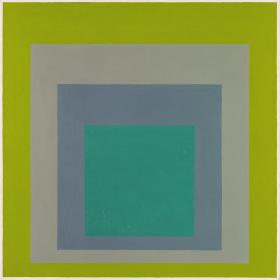Prep
- Make stacks of different papers.
- Make sure there are glue sticks and scissors for each student.
Set Up
- Place assorted stacks of papers on work tables.
- Have glue sticks and scissors ready (in tubs, if available).
- Place 9 x 12” black paper aside to mount finished collages.
Introduction/ Warm-Up
- Begin with a discussion of Albers’s Homage to the Square.
- Ask students to identify the shapes they see and count the squares they see. Are some hidden? Under? Over? Which color is “on top?”
- Discuss the meaning of overlapping. To demonstrate, have students overlap their hands or their arms over their legs.
- Talk about the colors in the work of art and how one can see there are different layers because of overlapping and variety in the artist’s color choices.
- Ask if anyone can share the meaning of the word “collage” with the class. Reinforce the definition if necessary.
Focus Activity Procedure
- Tell students they are going to be making collages out of shapes they will create themselves.
- Explain that they will be cutting and tearing paper to create new and interesting shapes to build their collages. Instruct them to make some big shapes, some medium shapes and some small so that they have different ways to overlap and combine their shapes and colors.
- Students should begin by choosing their colors and tearing paper to see what shapes they get. They will create a small pile of shapes in various colors.
- Pass out tubs of scissors at this point and have them cut some new shapes. Point out the difference in the edges and shapes they can now produce.
- When students have a nice variety of collage pieces, give them the glue and a full piece of 8 x 10” paper (color of their choosing) and let them make their collages, reminding them to have overlapping areas. Remind them of Homage to the Square and talk about planning a picture before they start, or just seeing what happens naturally as they play with the pieces they have made. Emphasize that both approaches are fine.
- As students finish, fix their finished work to a larger piece of black paper. Students should write their names on the back.
Closing
- Clean up.
- Gather class for closing conversation.
- Ask the students which type of piece helped make their art special. Did they prefer the cut pieces or the torn pieces?
- Hold up student work and have students take turns pointing out their favorite shape/color combinations.
- Ask students to look for art all around them at home and at school.
- Student work may be used to assess students’ ability to create approximate shapes from torn paper and position them in layers.
- Ask students to name the different layers (bottom, middle, top) in their artwork.
collage
layer
overlap
Different papers in interesting textures and colors, nontoxic glue sticks, 9 x 12” black construction paper (to mount final work)
Extension Activities for Teachers
- Invite students on a scavenger hunt around classroom/home to find other overlapping shapes. Invite students to make a different type of collage.
Extension Activities for Families
- Think about things that overlap at home. Look at plates on your table, rugs on your floors, toys on your rug.
- Use old magazines and newspapers to cut or tear out images to make a collage as a family. What would a collage of only words look like?
Related Books
Brocket, Jane. Ruby, Violet, Lime: Looking for Color. Millbrook, 2012. [ISBN 978-0-7613-4612-8]
Ehlert, Lois. Color Farm. Lippincott, 1990. [ISBN 978-0-397-32441-5]
Ehlert, Lois. Color Zoo. HarperCollins, 1989. [ISBN 978-0-397-32259-6]
Hoban, Tana. Colors Everywhere. HarperCollins/Greenwillow, 1995. [ISBN 978-0-688-12762-6]
Hoban, Tana. Is It Red? Is It Yellow? Is It Blue?: An Adventure in Color. HarperCollins/Greenwillow, 1978. [ISBN 978-0-688-80171-7]
Hoban, Tana. Of Colors and Things. HarperCollins/Mulberry, 1996, 1989. [ISBN 978-1-41316-654-5]
Hoban, Tana. Shapes, Shapes Shapes. HarperCollins/Greenwillow, 1986. [ISBN 978-0-688-05832-6]
Houblon, Marie. A World of Colors: Seeing Colors in a New Way. National Geographic, 2009. [ISBN 978-1-42630-556-6]
Lionni, Leo. Let’s Make Rabbits: A Fable. Random/Dragonfly, 1982. [ISBN 978-0-679-84019-0]
Luxbacher, Irene. 1 2 3 I Can Collage! Kids Can Press, 2009. [ISBN 978-1-55453-313-8]
Micklethwait, Lucy. I Spy Shapes in Art. HarperCollins/Greenwillow, 2004. [ISBN 978-0-06-073193-9]
Royston, Angela. Color. Heinemann Library, 2008. [ISBN 978-1-43291-432-5]
Shahan, Sherry. Spicy Hot Colors=Colores Picantes. Illustrated by Paula Barragan. AugustHouse, 2007, 2004. [ISBN 978-0-329-68420-4]
Thomas, Isabel. Making Collage. Heinemann Library, 2005. [ISBN 978-1-40346-922-9]
Walsh, Ellen Stoll. Mouse Paint. Harcourt, 1989. [ISBN 978-0-15-256025-6]
Walsh, Ellen Stoll. Mouse Shapes. Harcourt, 2007. [ISBN 978-0-15-206091-6]
Josef Albers used his Homage to the Square series, from which this work comes, not only to catalogue the behavior of color but also to explore its expressive potential. The squares, imbued with light, may have grown out of Albers's work with stained glass in his early career (some of which he spent teaching at Black Mountain College in western North Carolina). The shifts in color and internal scale make the squares recede, advance, or hover ambiguously in relation to one another. The clearly handmade surfaces give a gently uneven, hand-tooled quality to the painting. In the nested-square format, the scientist and the expressionist come together to reveal how color can distort and transform matter and form, creating effects that have emotional impact. "Abstract art," Albers wrote, "is the purest art: it strives most intensely toward the spiritual."


